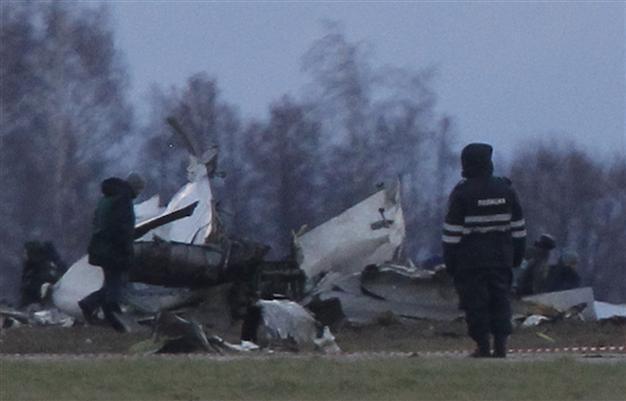Russia seeks answers over plane's 'vertical' crash
MOSCOW - Agence France-Presse

Wreckage is seen at the site of a Tatarstan Airlines Boeing 737 crash at Kazan airport November 18, 2013. REUTERS Photo
A Russian plane that crashed killing all 50 on board plunged nose-first into the ground, officials said Monday, as investigators focused on a fault with the 23-year old plane or pilot error as the likely cause for the disaster.
The Tatarstan Airlines' Boeing 737-500 crashed on landing at the airport in the Volga city of Kazan after a flight from Moscow's Domodedovo airport Sunday night, killing all 44 passengers and six crew on board, the emergencies ministry said.
"The main versions of what happened are an error in piloting and technical factors, including a technical failure," the head of the transport Investigative Committee for the Volga region, Alexander Poltinin, was quoted as saying by Russian news agencies.
He confirmed that the crash occurred while the aircraft was making a second attempt at landing and said the investigation would have to consider why the pilot had not managed to land the first time in reasonable weather conditions.
Transport Minister Maxim Sokolov, citing what he said was so far unpublished video footage of the disaster, revealed that the plane plunged nose first into the grounds of the airport and then appeared to have exploded.
"The plane simply fell. It went vertically into the ground. After the plane hit the ground there was an explosion," Sokolov was quoted as saying by the state RIA Novosti news agency in Kazan.
A source quoted by the Interfax news agency said that it was clear the plane had lost speed on its second approach although it was not immediately apparent why.
The disaster claimed the lives of Irek Minnikhanov, the son of the leader of the Tatarstan region, Rustam Minnikhanov, and the head of Russia's FSB security service in Tatarstan, Alexander Antonov.
Also among the dead was a Briton, Donna Carolina Bull, 53, and a Ukrainian national, Margarita Oshurkova, the emergencies ministry said. The rest of the victims are all believed to be Russian citizens.
Despite his personal tragedy, Minnikhanov was at the scene of the disaster and overseeing rescue operations, Russia's Deputy Prime Minister Arkady Dvorkovich told a cabinet meeting.
For unexplained reasons, the plane landed around 150 metres (500 feet) away from the main runway at Kazan airport and then exploded, with debris strewn over hundreds of metres, Russian state television said.
Images from the airport showed near-apocalyptic scenes, as fire fighters doused the unrecognisable wreckage of the plane with foam. Both black boxes have been found, Russian news agencies said.
State television quoted an air traffic controller at the airport, Kirill Kornishin, as saying he had spoken to one of the pilots after the first aborted landing and was told that the plane was not in a fit state to land.
The plane owned by Tatarstan Airlines, the regional carrier of the Tatarstan region in central Russia, was 23 years old and had had seven different owners during its life, Russian media and specialised websites said.
It went into service in 1990 and was used first by now defunct French airline Euralair Horizons and then by Air France. Before being acquired by Tatarstan Airlines it was operated by Uganda Airlines, Brazil's Rio Sul, Romania's Blue Air and then Bulgaria Air.
In 2001, while being operated by Rio Sul it suffered a serious accident on landing after a flight in Brazil which, although it claimed no lives, meant that the plane had to undergo serious repairs.
In November 2012, the plane had made an emergency landing back in Kazan after taking off from the airport owing to a data systems fault but no one was hurt, Russian media said.
Russia's Investigative Committee, which has already opened a criminal probe into the accident, seized documents from Tatarstan Airlines Monday to assist the investigation, it said in a statement. The head of Russia's aviation agency Rosaviatsia, Alexander Neradko, said the plane had over 56,000 flying hours behind it "which is a normal figure for a plane of this class." According to the RIA Novosti news agency, it last underwent a technical service in March 2012.
Russia has experienced a string of deadly air crashes, usually involving small and poorly regulated regional airlines that sprang up across Russia after the breakup of the Soviet Union.
